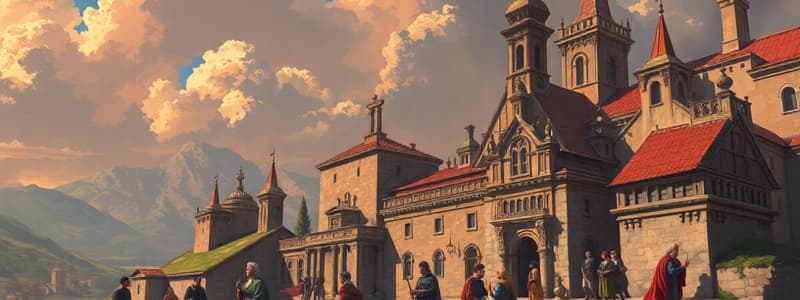Podcast
Questions and Answers
The rediscovery of ancient Greek and Roman texts in Italy was primarily led by scholars in Venice.
The rediscovery of ancient Greek and Roman texts in Italy was primarily led by scholars in Venice.
False (B)
Renaissance Humanism was influenced by the study of classical texts preserved in monasteries.
Renaissance Humanism was influenced by the study of classical texts preserved in monasteries.
True (A)
The Proto-Renaissance art style maintained the rigid, symbolic approach found in Byzantine art.
The Proto-Renaissance art style maintained the rigid, symbolic approach found in Byzantine art.
False (B)
Scholars transmitted ancient texts through translations made by Arab scholars.
Scholars transmitted ancient texts through translations made by Arab scholars.
Attention to human emotion characterized the art of the Proto-Renaissance.
Attention to human emotion characterized the art of the Proto-Renaissance.
The Proto-Renaissance occurred between the 11th and 13th centuries.
The Proto-Renaissance occurred between the 11th and 13th centuries.
The rise of cities such as Florence and Venice was a notable development during the Proto-Renaissance.
The rise of cities such as Florence and Venice was a notable development during the Proto-Renaissance.
The merchant class lost influence to the traditional landed nobility during the Proto-Renaissance.
The merchant class lost influence to the traditional landed nobility during the Proto-Renaissance.
Republican forms of government became prevalent in many city-states during the Proto-Renaissance.
Republican forms of government became prevalent in many city-states during the Proto-Renaissance.
The Holy Roman Empire's decline in Italy allowed for city autonomy.
The Holy Roman Empire's decline in Italy allowed for city autonomy.
The authority of the papacy strengthened during the Proto-Renaissance.
The authority of the papacy strengthened during the Proto-Renaissance.
The Franciscans emphasized the divinity of Christ over his humanity.
The Franciscans emphasized the divinity of Christ over his humanity.
The Proto-Renaissance culture involved a rediscovery of classical antiquity.
The Proto-Renaissance culture involved a rediscovery of classical antiquity.
Study Notes
Proto-Renaissance and Political Change
- The Proto-Renaissance, spanning from the 13th to the 14th centuries, represented a period of significant historical and political change in Europe.
Decline of Old Structures
- The feudal system, a traditional form of political organization, declined.
- The Holy Roman Empire lost influence in Italy, enabling cities to achieve greater autonomy.
- The papacy, once a dominant force, experienced periods of weakened power, allowing for more civic control and less ecclesiastical influence in political matters.
Rise of New Power Centers
- Cities like Florence, Milan, Venice, and Siena emerged as wealthy hubs of trade and finance.
- The growing merchant class gained influence over the traditional landed nobility.
- Republican forms of government took hold in many city-states.
Cultural Impact of Political Change
- The political dynamism and civic pride fostered by these shifts fueled cultural patronage.
Rediscovery of Classical Antiquity
- Scholars in Italy, especially in Florence, rediscovered and studied ancient Greek and Roman texts, often preserved in monasteries or transmitted by Arab scholars.
- This renewed interest in classical learning laid the intellectual foundation for Renaissance Humanism.
Artistic Evolution
- Proto-Renaissance art moved away from the rigid, symbolic style of Byzantine art.
- It embraced greater naturalism, depth, and attention to human emotion.
Studying That Suits You
Use AI to generate personalized quizzes and flashcards to suit your learning preferences.
Description
Test your knowledge of the Proto-Renaissance era and its significant political changes in Europe from the 13th to 14th centuries. Explore how the decline of feudalism, the rise of city-states, and the shift in power dynamics influenced the culture and governance of the time.




